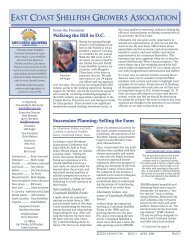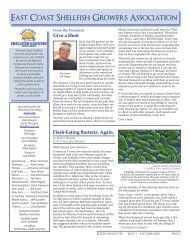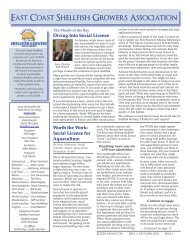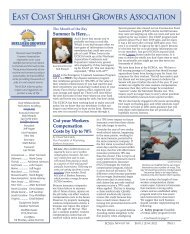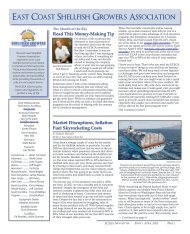ECSGA newsletter December 2022
Articles include: Why the ISSC conference is vital to your business; More on bird interactions with floating shellfish gear; What does the market for shellfish look like in the EU? Stay out of trouble with the IRS by following these tips; Mass oyster mortalities in North Carolina still a mystery; Some new reseach on microplastics in oysters and mussels; Oyster larvae respond to underwater sound! Hurricane Fiona causes millions in losses in Prince Edward Island, Canada; A full preview of all the upcoming shellfish aquaculture conferences this winter; Why do special interest groups have more clout than science? and NOAA's 5-year plan for aquaculture development.
Articles include: Why the ISSC conference is vital to your business;
More on bird interactions with floating shellfish gear;
What does the market for shellfish look like in the EU?
Stay out of trouble with the IRS by following these tips;
Mass oyster mortalities in North Carolina still a mystery;
Some new reseach on microplastics in oysters and mussels;
Oyster larvae respond to underwater sound!
Hurricane Fiona causes millions in losses in Prince Edward Island, Canada;
A full preview of all the upcoming shellfish aquaculture conferences this winter;
Why do special interest groups have more clout than science? and
NOAA's 5-year plan for aquaculture development.
You also want an ePaper? Increase the reach of your titles
YUMPU automatically turns print PDFs into web optimized ePapers that Google loves.
Farmed Oyster Mortality<br />
Increasing in North<br />
Carolina Estuaries<br />
by Tal Ben-Horin, NC State University Center<br />
for Marine Science and Technology;<br />
Rachel Noble, UNC Chapel Hill Institute of<br />
Marine Sciences; and<br />
Chris Matteo, North Carolina Shellfish<br />
Growers Association<br />
MARK CIESIELSKI/UNC<br />
Field researcher Thomas Clerkin deploying oyster<br />
lines to grow-out sites. Two of the researchers’<br />
North Carolina sentinel sites experienced<br />
complete mortality of all deployed oysters.<br />
North Carolina’s coastal sounds frequently<br />
experience episodic oyster mortality events<br />
during warm months. This year was no<br />
exception, with farms from Oregon Inlet to<br />
Brunswick County, and even south through<br />
Georgia, reporting heavy mortalities of midto<br />
market-sized oysters in late spring, again<br />
in late summer, and again in early fall. These<br />
events are often sudden, with near 100%<br />
mortality occurring over as few as three<br />
days. These dramatic events are typically<br />
localized to ocean-influenced coastal sounds,<br />
where salinities this summer routinely<br />
exceeded 40 ppt, and were likely magnified<br />
by the ongoing regional drought. The<br />
North Carolina Shellfish Growers Association,<br />
working with oyster farmers across the<br />
region, estimates that approximately 90% of<br />
farms located in high-salinity coastal sounds<br />
have been impacted this year. Up-estuary<br />
farms in locations such as Hyde and Pamlico<br />
counties did not report any unusual mortality<br />
this summer.<br />
Oyster mortality events across North<br />
Carolina in this and previous years must be<br />
considered within the broader context of<br />
other unexplained oyster mortalities occurring<br />
across the country and throughout the<br />
world, including the enigmatic triploid mortality<br />
events that have been observed over the<br />
past decade.<br />
With funding from the North Carolina Commercial<br />
Fishing Resources Fund, and in collaboration<br />
with colleagues at University of<br />
North Carolina Wilmington and the Virginia<br />
Institute of Marine Science, we deployed<br />
half-sibling diploid and triploid oyster lines<br />
to eight field sites across North Carolina and<br />
Virginia last fall to better understand oyster<br />
health and pathology associated with these<br />
recurring events. Our sentinel field sites experienced<br />
mortality in line with that reported<br />
from commercial oyster farms this summer,<br />
with two of our North Carolina sites experiencing<br />
complete mortality of all deployed<br />
oysters.<br />
Some sites saw more moderate mortality,<br />
while two North Carolina sites and all sites<br />
in Virginia experienced little to no mortality<br />
outside of what is seen over a typical<br />
summer. The diploid and triploid lines fared<br />
MARK CIESIELSKI/UNC<br />
Quantifying oyster mortality on the farm.<br />
Research suggests that impacted oysters are<br />
starving, even though food is plentiful in the<br />
growing waters.<br />
equally poorly at the impacted<br />
sites, where we saw similar pathology<br />
to previous years, characterized<br />
by sloughing absorptive<br />
cells within digestive tubules<br />
preceding mortality by two to<br />
three weeks, suggesting that impacted<br />
oysters are starving even<br />
with plentiful food in the water.<br />
We are still working through our<br />
data from this past summer, but<br />
in past years we have observed<br />
shifts in microbial communities<br />
associated with digestive tubule<br />
pathology, with Vibrio species<br />
becoming more dominant.<br />
Whether these microbial communities<br />
are the cause of disease<br />
or responding to pathology has<br />
become a major focus for our<br />
research groups.<br />
We are also heavily focused<br />
on how oyster farmers and the<br />
industry can move forward.<br />
We know that high salinity is<br />
a necessary precursor for these<br />
events to occur, but it is not<br />
the sole driver. This summer’s<br />
second mortality wave occurred<br />
— Continued on page 12<br />
<strong>ECSGA</strong> Newsletter<br />
Page 8 Issue 4 <strong>December</strong> <strong>2022</strong>




